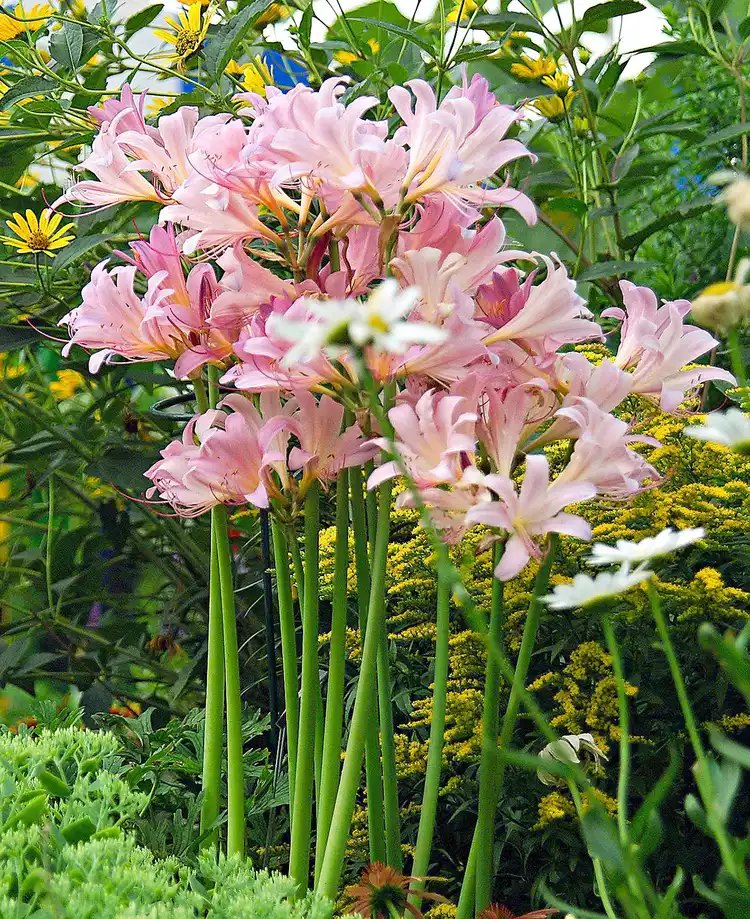As the name suggests, the spider lily has long, spiderlike petals on its flowers that appear from midsummer to fall. There are more than a dozen species in the Lycoris genus; all are native to Asia, but spider lilies are often assumed to be native to the United States because Lycoris radiata has naturalized in several states in the southeastern United States.
This hardy bulb has a curious habit of blooming on bare stems with no foliage present, which has earned it the common names "naked lady" and "surprise lily." It is also dubbed the hurricane lily, as it tends to bloom during hurricane season in the United States. The flower is a close relative to the amaryllis and much like its kin, has a striking flower. This plant generally puts out its foliage in spring after the coldest weather has passed.
All species in the Lycoris genus are toxic to humans and animals.
Spider Lily Overview
| Genus Name | Lycoris |
| Common Name | Spider Lily |
| Plant Type | Bulb |
| Light | Part Sun, Sun |
| Height | 1 to 3 feet |
| Width | 1 to 2 feet |
| Flower Color | Orange, Pink, Red, White, Yellow |
| Foliage Color | Blue/Green |
| Season Features | Fall Bloom, Summer Bloom |
| Special Features | Attracts Birds, Cut Flowers |
| Zones | 10, 5, 6, 7, 8, 9 |
| Propagation | Division |
| Problem Solvers | Deer Resistant |
Where to Plant Spider Lily
Spider lily should be ideally planted in a location with partial sun and well-drained soil that can be slightly acidic, neutral, or alkaline. It takes spider lily a couple of years to get established and start blooming. Pick a spot where the plants can remain undisturbed so they can form their typical small colonies.
Spider lilies can be planted in many places in the landscape—in a border or near a patio, in a cottage garden or naturalized area, as specimens, or in small groups. Because the foliage disappears during the summer, interplanting it with a slow-growing ground cover is a good idea.
How and When to Plant Spider Lily
Spider lily is planted in the early fall. Dig a hole only deep enough that the neck of the bulbs is barely covered by soil to about ¼ inch exposed. Planting spider lily too deeply will affect the ability to bloom.
The spacing depends on the variety. Lycoris radiata should be spaced 6 to 12 inches apart and Lycoris squamigera 6 inches apart.
Spider Lily Care Tips
Light
Spider lilies can be grown in full sun to part shade, though they'll flower best where they get some shade.
Soil and Water
Spider lilies require well-drained soil. They do fine in acidic, neutral, and alkaline soil (pH 6.0 to 8.0).
During the growing season, they should get an even supply of moisture. During their summer dormant period, they do best if the soil remains dry.
Temperature and Humidity
The hardiness depends on the species. Lycoris squamigera is the hardiest species in the genus that can be grown down to zone 5.
When planting Lycoris radiata at the lower end of its zone range, choose a sheltered location where the evergreen foliage is less likely to freeze in the winter so it can naturally die back in the spring.
Spider lilies are tolerant of humid conditions.
Fertilizer
Fertilize spider lily twice a year. In the early spring, use a high-nitrogen fertilizer which promotes foliage growth so the bulb can store nutrients. After the bloom in the later summer or fall, feed it with a fertilizer that is low in nitrogen but high in potassium and phosphorous to promote root growth, which prepares the plant for the winter.
Pruning
Other than removing dead foliage after the winter, spider lily does not require any pruning. Removing foliage, unless it’s diseased or dead, deprives the plant of the chance to store nutrients.
Potting and Repotting Spider Lily
Due to their deep and extensive root systems, growing spider lilies in pots is not recommended. Size is not the only concern. Even if you planted spider lily in large containers, at the lower end of the zone range, the bulbs are subject to frequent freeze-and-thaw circles during the winter, which are detrimental to bulbs.
Pests and Problems
Spider lilies have no serious problems insect or disease problems. Deer and rodents leave spider lily alone. Overwatering and poorly draining soil may lead to root rot.
How to Propagate Spider Lily
Spider lily can be easily propagated by division. The best time to do this is just after the plant goes dormant in early summer. Once the foliage has completely died back, dig up the bulbs. Division is not really necessary because these plants form multiple clumps on their own after a few years, so you just gently separate the clumps and replant them at the same depth in a new location.
Types of Spider Lily
Red Spider Lily
Gardeners in southern climates are likely to be familiar with Lycoris radiata. It bears loose clusters of bright red, spidery blooms in early fall. It grows 18 inches tall. Zones 7-10
White Spider Lily
Lycoris albiflora is another spider lily for the south, with white flowers that have elegantly curled petals. It grows 18 to 24 inches tall. Zone 8-10
Naked Lady
Lycoris squamigera is the hardiest spider lily species that produces its strappy leaves in spring and lilac-pink flowers in the fall. It grows 18 to 24 inches tall. Zones 5-10




















